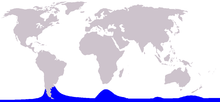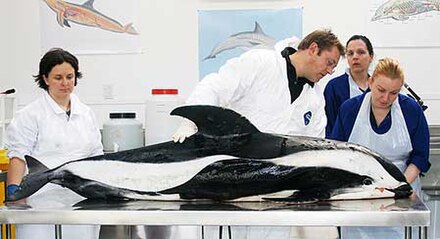Hourglass dolphin
| Hourglass dolphin | |
|---|---|

| |
| Hourglass dolphins leaping in the Drake Passage | |

| |
| Size compared to an average human | |
| Scientific classification | |
| Domain: | Eukaryota |
| Kingdom: | Animalia |
| Phylum: | Chordata |
| Class: | Mammalia |
| Order: | Artiodactyla |
| Infraorder: | Cetacea |
| Family: | Delphinidae |
| Genus: | Lagenorhynchus |
| Species: | L. cruciger
|
| Binomial name | |
| Lagenorhynchus cruciger | |

| |
| Hourglass dolphin range | |
The hourglass dolphin (Lagenorhynchus cruciger) is a small dolphin in the family Delphinidae that inhabits offshore Antarctic and sub-Antarctic waters.[3] This is one of very few species to be considered completely Antarctic, as it lives in Arctic waters and no where else. It is commonly seen from ships crossing the Drake Passage, but has a circumpolar distribution.
The species was identified as a new species by Jean René Constant Quoy and Joseph Paul Gaimard in 1824 from a drawing made in the South Pacific in 1820.[4] It is the only cetacean to have been widely accepted as a species solely on witness accounts. This species is very undiscovered and there is not much information regarding it.
Description

The hourglass dolphin is colored black on top and white on the belly, with white patches on the sides and sometimes variations of dark grey.[5] For this reason, it was colloquially known by whalers as a "sea cow"[6] (although it does not belong to the taxonomic order Sirenia) or "sea skunk".[5] Each flank has a white patch at the front, above the beak, eye and flipper, and a second patch at the rear. These two patches are connected by a thin white strip, creating, loosely speaking, an hourglass shape; hence the common name of the dolphin. The markings on each dolphin can vary between individuals. The scientific name cruciger means "cross-carrier" and refers to the area of black coloration, which, viewed from above, vaguely resembles a Maltese cross or cross pattée.[5] An hourglass dolphin has anywhere from 26-34 teeth in their upper jaw and 27-35 teeth in their lower jaw. These dolphins are smaller, therefore they eat smaller species. Their teeth are not very large and not sharp. There have been no verified sightings of calves and their coloration, size, and diet remains unknown.
In its usual range the dolphin is easily identifiable. The southern right whale dolphin is the only cetacean of comparable size and comparable coloration with overlapping distributions that lives as far south.[7] The absence of a dorsal fin in right whale dolphins, in contrast to the generally tall and curved dorsal fin of hourglass dolphins makes confusion of the two species very unlikely. The dorsal fin in hourglass dolphins is variable and the curvature may be particularly pronounced in older animals. The hourglass dolphin has disk-shaped vertebrae and other inclined processes which gives them higher stability.[8]
An adult male is about 1.8 meters (5.9 feet) in length and weighs over 90 kilograms (about 200 lbs).[4][9] Juvenile females range from 1.6 to 1.8 meters (5.2 to 5.9 ft) in length and weigh from 70 to 90 kg (150 to 200 lb).[4] Although this species is small, they are extremely fast and agile. Males are thought to be slightly smaller and lighter than females, although the small number of specimens does not permit a firm conclusion.
Female gestation periods are estimated to be 12.9 months and they tend to give birth between mid to late July through October.
Like all species of dolphins, they use echolocation to find food.[10]
Geographic range and distribution
The range is circumpolar from close to the Antarctic pack ice to about 45°S.[3] The northernmost confirmed sightings are 36°S in the South Atlantic Ocean and 33°S near Valparaíso, Chile, in the Pacific.[11] The overall circumpolar distribution is about 45°S to 67°S, with few sightings made near islands and the majority in the Arctic ocean. Sightings have been made most commonly from the south of New Zealand, around the South Shetland Islands[12] and off Tierra del Fuego, Argentina.[11]
Habitat
The hourglass dolphins is a completely Antarctic species and has been sighted in Arctic waters. Few have been seen near neighboring islands. This species prefers colder water so they spend most time closer to the surface where the temperature is around -0.3°C to 7°C. The warmest waters hourglass dolphins have reportedly swam in was around 14°C.
During the warmer months, hourglass dolphins are said to move more south toward the pole to find cooler waters. The furthest northern sighting of an hourglass dolphin was off the cost of Chile during a winter month. Hourglass dolphins tend to migrate more north during the winter.
Behavior
Hourglass dolphins are often seen in smaller groups up to 10–15 individuals,[7] though groups of up to 100 have been observed.
They share feeding grounds with other cetaceans such as pilot whales, minke whales and southern right whale dolphins and are regularly seen with fin whales.[7] Hourglass dolphins frequently bow-ride waves from ships and baleen whales. There has been observations of hourglass dolphins connecting with many species of whale, such as southern bottlenose whales, orcas, and Arnoux's beaked whales.
Examinations of the stomach contents of the few specimens indicate they eat mantis shrimp, polychaete worms, and various (unrecorded) species of squid and small fish.[13] They tend to feed closer to the surface, as they like cooler temperatures.
The life-span of an hourglass is also unknown due to small amounts of sightings and research. Their life-span is estimated to be similar to the Atlantic white-sided dolphin and Pacific white-sided dolphin, around 27-46 years.
Taxonomy
The species was first named Delphinus cruciger by Quoy and Gaimard (1824) after their sighting in January 1820.[4] Lesson and Garnot (1827) named another dolphin with two white patches on the sides Delphinus bivittatus.[4] Throughout the 19th and early 20th centuries, scientists have given the hourglass dolphin various synonyms, including Phocoena crucigera (Philippi, 1893), Electra crucigera (Gray, 1871), and Lagenorhynchus clanculus (Gray, 1846; 1849; 1850; 1866).[4] Though it is traditionally placed in the genus Lagenorhynchus, molecular analyses suggest the species is more closely related to the right whale dolphins and dolphins of the genus Cephalorhynchus[14][15] and it has been suggested that it should be moved to a new genus Sagmatias.[16][15] The taxonomic relationship with the genus Cephalorhynchus (which includes, among others, Hector's dolphin) is further supported by the similarity of the echolocation signals to the signals used by Cephalorhynchus-species.[10]
Population status
Sighting surveys were conducted in 1976–77 and 1987–88. Abundance was estimated to be 144,300 individuals, based on line transect sightings in January 1977 and January 1988 in northern Antarctic waters.[17] As of a report published July 12, 2023, the population is estimated to be under 140,000. While the population of the hourglass dolphins has slightly declined since 1988, they are not considered endangered.
Conservation status
The hourglass dolphin is covered by the Memorandum of Understanding for the Conservation of Cetaceans and Their Habitats in the Pacific Islands Region (Pacific Cetaceans MOU).[18] They are also listed in Appendix II of the Convention on International Trade in Endangered Species (CITES). Hourglass dolphins are not considered a truly endangered species and there is no known predators that would impact their population. Few dolphins have been reported entangled in fishing line and nets. Although they have not been studied extensively, there are no known major threats to hourglass dolphins, and the species is listed as "Data Deficient" according to the ICUN, and Least Concern on the IUCN Red List.[1]
See also
References
- ^ a b Braulik, G. (2018). "Lagenorhynchus cruciger". The IUCN Red List of Threatened Species: e.T11144A50361701. doi:10.2305/IUCN.UK.2018-2.RLTS.T11144A50361701.en.
- ^ "Appendices | CITES". cites.org. Retrieved 14 January 2022.
- ^ a b Van Waerebeek, K.; Leaper, R.; Baker, A.N.; Papastavrou, V.; Thiele, D.; Findlay, K.; Donovan, G.; Ensor, P. (2010). "Odontocetes of the Southern Ocean Sanctuary". Journal of Cetacean Research and Management. 11: 315–346.
- ^ a b c d e f Goodall, R.N.P.; Baker, A.N.; Best, P.B.; Meyer, M.; Miyazaki, N. (1997). "On the Biology of the Hourglass Dolphin, Lagenorhynchus cruciger (Quoy and Gaimard, 1824)". Reports of the International Whaling Commission. 47: 985–1000.
- ^ a b c Reeves, Randall R.; Stewart, Brent S.; Clapham, Phillip J.; Powell, James A. (2002). Guide to marine mammals of the world. New York: Alfred A. Knopf. pp. 414–417.
- ^ "OBIS-SEAMAP". seamap.env.duke.edu.
- ^ a b c Goodall, R.N.P. (1997). "Review of sightings of the Hourglass Dolphin, Lagenorhynchus cruciger, in the South American Sector of the Antarctic and Sub-Antarctic". Reports of the International Whaling Commission. 47: 1001–1014.
- ^ Constanza Marchesi, M.; Sebastían Mora, M.; Elena Pimper, L.; Alberto Crespo, E.; Goodall, R. (2017). "Can habitat characteristics shape vertebral morphology in dolphins? An example of two phylogenetically related species from southern South America". Marine Mammal Science. 33 (4): 1126–1148. doi:10.1111/mms.12432.
- ^ Brownell Jr., R. L; Donahue, M.A. (1999). Hourglass dolphin Lagenorhynchus cruciger (Quoy and Gaimard, 1824). In: S. H. Ridgway and R. Harrison (eds), Handbook of marine mammals, Vol. 6: The second book of dolphins and the porpoises. Academic Press. pp. 121–135.
- ^ a b Tougaard, J.; Kyhn, L.A. (2009). "Echolocation sounds of hourglass dolphins (Lagenorhynchus cruciger) are similar to the narrow band high‐frequency echolocation sounds of the dolphin genus Cephalorhynchus". Marine Mammal Science. 26 (1): 239–245. doi:10.1111/j.1748-7692.2009.00307.x.
- ^ a b Dellabianca, N.; Scioscia, G.; Schiavini, A.; Raya Rey, A. (2012). "Occurrence of hourglass dolphin (Lagenorhynchus cruciger) and habitat characteristics along the Patagonian Shelf and the Atlantic Ocean sector of the Southern Ocean". Polar Biology. 35 (2): 1921–1927. doi:10.1007/s00300-012-1217-0. hdl:1834/17143. S2CID 15289195.
- ^ Santora, J.A. (2011). "Habitat use of hourglass dolphins near the South Shetland Islands, Antarctica". Polar Biology. 35 (5): 801–806. doi:10.1007/s00300-011-1133-8. S2CID 14766528.
- ^ Fernandez, M.; Beron-Vera, B.; Garcia, N.A.; Raga, J.A.; Crespo, E.A. (2003). "Food and Parasites from two Hourglass Dolphins, Lagenorhynchus cruciger (Quoy and Gaimard, 1824), from Patagonian waters". Marine Mammal Science. 19 (4): 832–836. doi:10.1111/j.1748-7692.2003.tb01133.x.
- ^ May-Collado, L.; Agnarsson, I. (2006). "Cytochrome b and Bayesian inference of whale phylogeny". Molecular Phylogenetics and Evolution. 38 (2): 344–354. doi:10.1016/j.ympev.2005.09.019. PMID 16325433.
- ^ a b LeDuc, R.G.; Perrin, W.F.; Dizon, A.E. (1999). "Phylogenetic relationships among the delphinid cetaceans based on full cytochrome b sequences". Marine Mammal Science. 15 (3): 619–648. doi:10.1111/j.1748-7692.1999.tb00833.x.
- ^ Vollmer, Nicole L.; Ashe, Erin; Brownell, Robert L.; Cipriano, Frank; Mead, James G.; Reeves, Randall R.; Soldevilla, Melissa S.; Williams, Rob (2019). "Taxonomic revision of the dolphin genus Lagenorhynchus". Marine Mammal Science. 35 (3): 957–1057. doi:10.1111/mms.12573. ISSN 1748-7692. S2CID 92421374.
- ^ Kasamatsu, F.; Joyce, G.G. (1995). "Current status of Odontocetes in the Antarctic". Antarctic Science. 7 (4): 365–379. doi:10.1017/S0954102095000514. S2CID 129033176.
- ^ "Pacific Cetaceans – Convention on Migratory Species". Pacific Cetaceans.
[1]
[2]
[3]
External links
 Media related to Lagenorhynchus cruciger at Wikimedia Commons
Media related to Lagenorhynchus cruciger at Wikimedia Commons- Lagenorhynchus cruciger – Hourglass Dolphin, Species Profile and Threats Database, Australian Government Department of the Environment and Energy
- OBIS SEAMAP hourglass dolphin species profile, Duke University
- ^ Dellabianca, Natalia; Scioscia, Gabriela; Schiavini, Adrián; Raya Rey, Andrea (1 December 2012). "Occurrence of hourglass dolphin (Lagenorhynchus cruciger) and habitat characteristics along the Patagonian Shelf and the Atlantic Ocean sector of the Southern Ocean". Polar Biology. pp. 1921–1927. doi:10.1007/s00300-012-1217-0. Retrieved 18 April 2024.
- ^ Santora, Jarrod A. "Habitat use of hourglass dolphins near the South Shetland Islands, Antarctica". Springer Link. Springer Link. Retrieved 18 April 2024.
- ^ Mcintosh, Colline; Corbett, Jessica. "20 Hourglass Dolphin Facts". Facts.net. Facts.net. Retrieved 18 April 2024.
